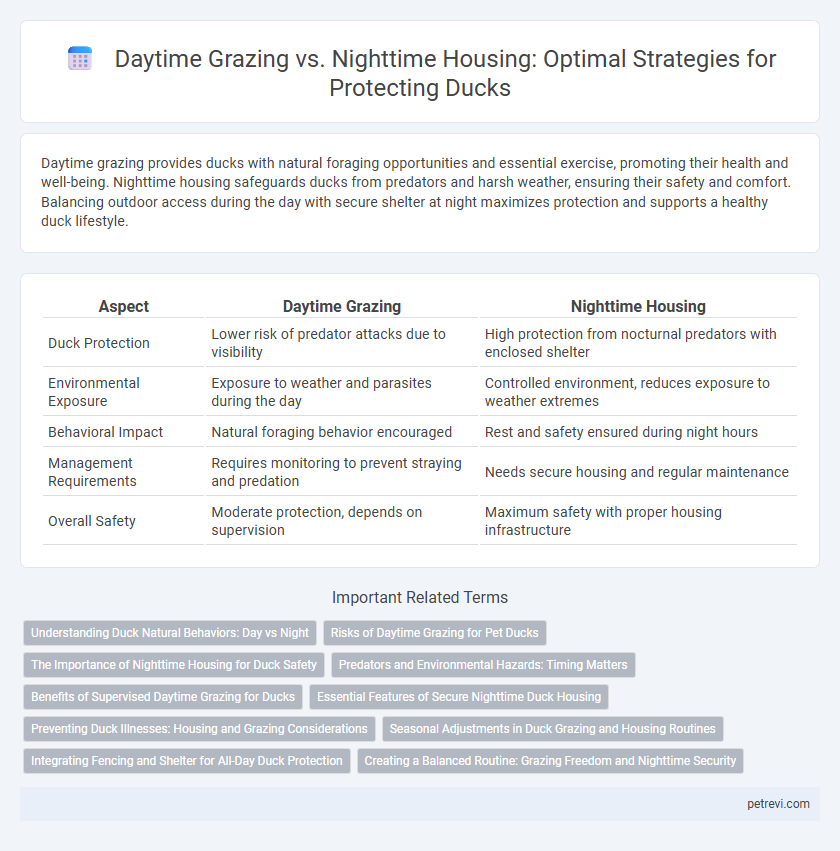Daytime grazing provides ducks with natural foraging opportunities and essential exercise, promoting their health and well-being. Nighttime housing safeguards ducks from predators and harsh weather, ensuring their safety and comfort. Balancing outdoor access during the day with secure shelter at night maximizes protection and supports a healthy duck lifestyle.
Table of Comparison
| Aspect | Daytime Grazing | Nighttime Housing |
|---|---|---|
| Duck Protection | Lower risk of predator attacks due to visibility | High protection from nocturnal predators with enclosed shelter |
| Environmental Exposure | Exposure to weather and parasites during the day | Controlled environment, reduces exposure to weather extremes |
| Behavioral Impact | Natural foraging behavior encouraged | Rest and safety ensured during night hours |
| Management Requirements | Requires monitoring to prevent straying and predation | Needs secure housing and regular maintenance |
| Overall Safety | Moderate protection, depends on supervision | Maximum safety with proper housing infrastructure |
Understanding Duck Natural Behaviors: Day vs Night
Ducks exhibit distinct natural behaviors during daytime and nighttime that influence their protection strategies. During the day, they engage actively in grazing, foraging, and social interactions, which requires open, safe environments with abundant vegetation. At night, ducks prefer secure, sheltered housing to avoid predators, as their nocturnal behavior involves resting and reduced movement, making nighttime housing essential to protect their well-being.
Risks of Daytime Grazing for Pet Ducks
Daytime grazing exposes pet ducks to predators such as hawks, foxes, and neighborhood dogs, increasing the risk of attacks and stress. Sun exposure during long grazing hours can cause overheating and dehydration, especially in hot climates, compromising their health. Furthermore, parasites and toxic plants are more likely encountered during daylight, posing additional health risks to free-ranging ducks.
The Importance of Nighttime Housing for Duck Safety
Nighttime housing provides essential protection for ducks against predators such as foxes, raccoons, and birds of prey, significantly reducing mortality rates. Secure, well-ventilated coops with proper fencing not only safeguard ducks during vulnerable nighttime hours but also prevent exposure to harsh weather conditions. Consistent nighttime shelter enhances overall duck welfare, promoting healthier growth and reducing stress-induced behaviors.
Predators and Environmental Hazards: Timing Matters
Daytime grazing allows ducks to forage while visibility reduces predator attacks from foxes, raccoons, and birds of prey, enhancing natural vigilance. Nighttime housing protects ducks from nocturnal predators and harsh environmental hazards such as low temperatures and heavy dew, preventing stress and illness. Proper management of grazing and housing times balances safety and nutrition to optimize duck health and survival.
Benefits of Supervised Daytime Grazing for Ducks
Supervised daytime grazing allows ducks to forage naturally, enhancing their diet with diverse insects and plants that boost nutrition and immune health. Exposure to sunlight during the day promotes vitamin D synthesis, essential for strong bones and overall vitality. This controlled grazing environment reduces predation risk by allowing caretakers to monitor and protect ducks effectively.
Essential Features of Secure Nighttime Duck Housing
Secure nighttime duck housing requires sturdy, predator-proof enclosures constructed from durable materials such as heavy-gauge wire mesh and solid wood to prevent access by foxes, raccoons, and owls. Ventilation must be optimized to ensure fresh air circulation without compromising insulation, maintaining a comfortable temperature for ducks throughout the night. Elevated sleeping areas and easy-to-clean flooring reduce moisture buildup and disease risk, establishing a safe, hygienic environment crucial for duck protection during nighttime hours.
Preventing Duck Illnesses: Housing and Grazing Considerations
Proper daytime grazing allows ducks to access natural sunlight and fresh air, which boosts their immune systems and reduces the risk of respiratory infections. Nighttime housing should provide secure, well-ventilated shelters to protect ducks from predators and harsh weather conditions, minimizing stress-related illnesses. Ensuring clean, dry bedding and regular sanitation in housing areas further prevents the spread of infectious diseases among duck populations.
Seasonal Adjustments in Duck Grazing and Housing Routines
Seasonal adjustments in duck grazing and housing routines are essential for optimal protection and health. During warmer months, daytime grazing allows ducks to forage efficiently while benefiting from natural sunlight and insect availability, whereas in colder seasons, nighttime housing provides shelter from harsh weather and predators. Adapting grazing schedules and housing environments to seasonal changes improves overall duck welfare and productivity throughout the year.
Integrating Fencing and Shelter for All-Day Duck Protection
Integrating sturdy fencing with well-designed shelter ensures comprehensive protection for ducks by preventing predators during nighttime and minimizing risks during daytime grazing. Durable mesh fences combined with covered enclosures create a safe environment that supports ducks' natural behaviors while reducing exposure to threats. This all-day protection strategy enhances duck welfare and productivity by balancing freedom of movement with security.
Creating a Balanced Routine: Grazing Freedom and Nighttime Security
Providing ducks with ample daytime grazing promotes natural foraging behavior and improves overall health by exposing them to sunlight and fresh air. Nighttime housing offers essential protection from predators and harsh weather conditions, ensuring their safety and comfort. Balancing open pasture access during the day with secure nighttime shelters enhances both the welfare and productivity of duck flocks.
Daytime Grazing vs Nighttime Housing for Duck Protection Infographic

 petrevi.com
petrevi.com